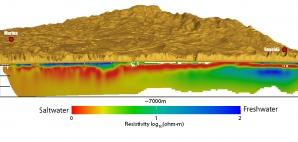A new way to see saltwater intrusion into groundwater
by Ker Than on 6 Apr 2014

Map of underground saltwater-freshwater interface along the California coast between Marina and Seaside made using electrical resistivity tomography. Rosemary Knight
A Stanford geophysicist has employed novel surface technology to study intrusion of saltwater into freshwater aquifers along the California coast.
California coastal communities have long been dependent on groundwater to satisfy their drinking and farming water needs. But the amount of pumping is drawing seawater into coastal aquifers and corrupting water supplies. 'Once you have saltwater in your freshwater aquifer, it’s hard to get it back out,' said Rosemary Knight, a leading geophysicist and an expert in developing and using leading edge technologies to generate images enabling the evaluation and management of groundwater resources. Knight is a Stanford Woods Institute senior fellow, by courtesy.
To better understand how serious this problem is in California, Knight and her team are testing a new technique to map where underground pockets of freshwater and saltwater meet along the coast of Monterey Bay. The technique, called electrical resistivity tomography, can map out the salinity of groundwater. It involves sinking electrical rods that are connected by a wire into the ground and running an electrical current through the wire. 'The technology measures a property called electrical resistivity,' said Knight, the George L. Harrington Professor in Stanford Earth Sciences and also a senior fellow at the Stanford Woods Institute for the Environment. 'If you have more salt in the water, it’s electrically conductive. If you have very little salt, it’s electrically resistive.'
Upon request of Monterey area Stanford alumni, Knight recently explained her research and the technique her team developed at an invitation-only event.
In a pilot study conducted along a four-mile (seven-km) stretch of coastline between the cities of Seaside and Marina in 2012, Knight and her team successfully created an electrical resistivity map that reached a depth of nearly 500 feet (150 meters). A larger field experiment, slated for late October, will create a similar map for the entire accessible coastline of Monterey Bay–a distance of about 28 miles (45 kilometers). Knight expects that map will probe to a depth of nearly 1,000 feet (300 meters). This work is being conducted in collaboration with Adam Pidlisecky from the University of Calgary, formerly a graduate student with Knight and an expert in the acquisition and interpretation of electrical resistivity data.
California communities are reliant on groundwater aquifers to meet their water needs. In Santa Cruz County, about 70 percent of the freshwater comes from aquifers; in Monterey County, the figure is nearly 100 percent. Pumping freshwater out of the ground changes the fluid pressure of aquifers, and if an aquifer is located near the coast, it can lead to saltwater intrusion. 'There’s a delicate pressure balance between the groundwater and the saltwater,' Knight said. 'When you pump the groundwater, the saltwater can move in.'
The problem could worsen in coming years if the state’s current drought continues. A drought would not only lead to more groundwater pumping because of increased water demands, it would also mean less water going into aquifers . 'At any time, it’s a balancing act between the amount of water that goes into the aquifer and the amount that comes out,' Knight said. 'During a drought, there is less precipitation, so the natural recharge of the aquifer does not occur.'
If Knight’s team can show that electrical resistivity tomography works at larger scales, it would be a better alternative than the current method used to monitor saltwater intrusion, which involves drilling so-called 'sentinel' wells at specific sites. 'The problem with wells is you’re only getting data at one specific point,' Knight said. Wells are also expensive. Four of the wells used to monitor saltwater intrusion along Monterey Bay had a cost estimate of nearly $1 million to drill. The Stanford team may be able to do a better job for a fraction of the cost.
Knight hopes that the data her team collects can be used to inform groundwater management decisions in California. 'Options could include changing the locations and extent of pumping to reduce the extraction of freshwater from the aquifers. It could also include proactively increasing the freshwater going into the aquifers through the engineered injection or infiltration of freshwater,' Knight said.
'If this problem is not addressed soon, we will need to look elsewhere for a supply of freshwater for the Monterey Bay region.'
If you want to link to this article then please use this URL: www.sail-world.com/120868